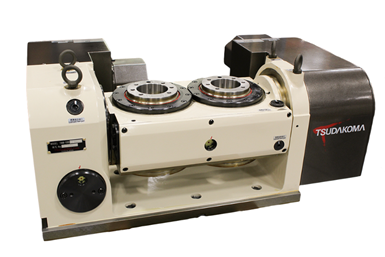Dual-Platter, Five-Axis Rotary Table
IMTS22: Koma Precision’s Tsudakoma TWM-250 can be setup for simultaneous five-axis movement or 4+1, enabling the machine to get around five sides of the workpiece.
Share







Autodesk, Inc.
Featured Content
View More


ECi Software Solutions, Inc.
Featured Content
View MoreKoma Precision showcases the dual platter Tsudakoma TWM-250 five-axis rotary table. This high precision unit has two 10" platters that can be equipped with rotary unions for hydraulic or pneumatic work holding actuation. The unit can be setup for 12-16" between platters, which Koma says enables for a variety of work holding and workpiece shapes and sizes.
The TWM series is said to be ideal for high-production single or dual spindle VMC’s that require five-axis machining. The TWM series unit can be setup for simultaneous five-axis movement or 4+1, enabling the machine to get around five sides of the workpiece. The hydraulic brake on the tilt axis reportedly provides 3100 Nm of brake torque, which enables the machine to take heavier cuts at more aggressive speeds and feeds while maintaining the accuracy of the part. According to Koma, the machine tool is only as accurate as the work holding and rotary table; therefore, the rigidity is critical to the entire throughput rate and quality of the cutting process.
For smaller machining centers, Koma offers the TWM series from 4"-8" platters as well, making these units appropriate for 30-, 40- and 50-taper machining centers. Smaller units can be equipped with 5C and other smaller collet style work holding devices.
Related Content
-
6 Trends in Additive Manufacturing Technology
IMTS 2024 features a larger Additive Manufacturing Pavilion than ever before, with veteran suppliers alongside startups and newcomers at the front of the West Building. As you browse these exhibitors, as well as booths found elsewhere at the show, keep an eye out for these trends in AM.
-
Tsugami Lathe, Vertical Machining Center Boost Machining Efficiency
IMTS 2024: Tsugami America showcases a multifunction sliding headstock lathe with a B-axis tool spindle, as well as a universal vertical machining center for rapid facing, drilling and tapping.
-
DN Solutions America Unveils Impressive Chicago Technical Center at IMTS 2024
New tech center is serving as a cutting-edge showroom and a technological hub for advanced machining applications.
























.png;maxWidth=150)










